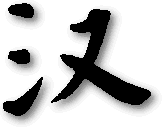


HAN206 B.C. - A.D. 220
Xin 8 - 23 Eastern (Later) Han 25 - 220 |

|
After a short civil war, a new dynasty, called Han (206 B.C.-A.D. 220), emerged with its capital at Chang'an.
The new empire retained much of the Qin administrative structure but retreated a bit from centralized rule by establishing vassal principalities in some areas for the sake of political convenience.
After some modifications of the harsher aspects of Confucianism from the previous Qin Dynasty Confucianism was now revived. Confucian scholars gained prominent status as the core of the civil service. The Confucian works - copies of which had been destroyed in the preceding period - were restored to favor, canonized, and taught by learned scholars in national academies. A civil service examination system was initiated based on these works. Candidates for responsible government positions received their appointments on the strength of their knowledge of classic literature. As a result, Confucianism secured a firm hold on Chinese intellectual and political life.
The success of Han Confucianism was attributable to Tung Chungshu (179?-104? BC), who first recommended a system of education built upon the teachings of Confucius. Tung Chungshu believed in a close correspondence between human beings and nature; thus a person's deeds, especially those of the sovereign, are often responsible for unusual phenomena in nature. Because of the sovereign's authority, he or she is to blame for such phenomena as fire, flood, earthquake, and eclipse. Because these ill omens can descend on earth as a warning to humanity that all is not well in this world, the fear of heavenly punishment proves useful as a curb to the monarch's absolute power. This was all contained in the idea of Tianming - The Mandate of Heaven.
The people of the Kingdom of Min-Yue (202-110 BC) in northern Fujian and southern Zhanjiang in southeast China were forced to move northwards to the Yangtze and the Huaihe regions after the King of Yue's failure to topple the Han dynasty.
The historian Sima Qian
The Han period produced China's most famous historian, Sima Qian (145-87 B.C.?), whose Shiji (Historical Records) provides a detailed chronicle from the time of a legendary Xia emperor to that of the Han emperor Wu Di(141-87 B.C.). Technological advances also marked this period. Two of the great Chinese inventions, paper and porcelain, date from Han times.
The Silk Route
The Han dynasty, after which the members of the ethnic majority in China, the "people of Han," are named, was notable also for its military prowess. The empire expanded westward as far as the rim of the Tarim Basin (in modern Xinjiang-Uyghur Autonomous Region), making possible relatively secure caravan traffic across Central Asia to Antioch, Baghdad, and Alexandria.
The paths of caravan traffic are often called the "silk route" because the route was used to export Chinese silk to the Roman Empire. Chinese armies also invaded and annexed parts of northern Vietnam and northern Korea toward the end of the second century B.C.
The Tributary System
During the Han dynasty a mutually beneficial "tributary" system was developed to ensure peace with non-Chinese local powers. Non-Chinese states were allowed to remain autonomous in exchange for symbolic acceptance of Han overlordship. Tributary ties were confirmed and strengthened through intermarriages at the ruling level and periodic exchanges of gifts and goods.
Wang Mang
After 200 years Han rule was interrupted briefly by Wang Mang in A.D. 9-24 and then restored for another 200 years.
The Han rulers, however, were unable to adjust to what centralization had wrought: a growing population, increasing wealth and resultant financial difficulties and rivalries, and ever-more complex political institutions. Riddled with the corruption characteristic of the dynastic cycle, by A.D. 220 the Han empire collapsed.

Webpage © Jan-Erik Nilsson, Gothenburg, Sweden, 2002